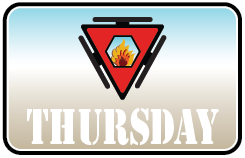Layer Ten, Week Three – Sunday
- Read Week Three Concepts
- Watch videos and read descriptions for Energetic Interplay and Reactionism – Range and Tolerance.
- Do Movements – Energetic Interplay and Reactionism – Range and Tolerance.
Sunday’s Focus
List your greatest fears (or at least mentally acknowledge them). Prioritize your list and identify the top three. One might be a thing but the other two are probably situational (fear of flying, public speaking, heights, intimacy, the dark, death, failure, commitment, etc.)
Sunday’s Concepts
Last week, we discussed the path out of reactionism. This week, let’s explore the energetics of external triggers and how the value you place on fear leads to reaction and imbalance.
Do you remember when we talked about threat assessment a few weeks ago? (L9W2) – Your environmental body is in near constant threat assessment. It tries to pull energy from your mental and emotional bodies by prioritizing external stimuli over internal sensations. You are undermined and sabotaged by your environmental body when you worry more about what others think or might do … than what is most beneficial.
When you are in threat assessment, you are preparing yourself to react. When you are looking for opportunities, you are preparing yourself to respond. To find opportunity, you must be looking for it. Before you are triggered (react), you must be in threat assessment.
Triggers appear as you prepare to be frightened and get ready to react. They are born from fear. The instant any degree of fear arises, a trigger is established. The sensitivity of the trigger is based on the amount of energy the fear has.
If you have a fear of spiders, you will be in constant preparation (energy configuration) for the possibility that you will encounter an eight-legged soul-sucking monster. You presumptively configure your energy as if you are about to be frightened.
Layer Ten, Week Three – Monday
- Read Monday Concepts
- Do Movements – Energetic Interplay and Reactionism – Range and Tolerance.
Monday’s Focus
How does the value you place on fears change depending on where you are? (You will be more fearful in a cave than a bus station if you fear dark, dirty, quiet places with bats and funny smells.)
Monday’s Concepts
It bears repeating, if you react, it is because you were predisposed (configured) for that reaction. Do you react when someone says something critical? While you might not have expected it, you feared it. Fearing critique predisposes you toward reacting to criticism. If you taught from an early age to welcome criticism as constructive, you would be predisposed to respond to it positively. You would view it from a place of potential opportunity, “What could this person say that will help me be more masterful, efficient, fulfilled, or successful?”
Unfortunately, very few of us, and no one I know, was brought up that way. The ones who have learned and grown to feel the opportunity in criticism have done so with intention, determination, and empathy. Empathy for themselves and the critic.
The rest of us are primed for reaction and not just to criticism but to the triggers for every fear we hold. Everyone has fears and we all are predisposed to be subconsciously hyper-reactive to those fears.
Every external trigger is born from an internal fear.
The birth of the internal fear creates an entity. Fear takes on a life of its own. The size of the entity is determined by the value (energy) you feed it and the size of the room you give it in your house (energy body).
Triggers are the doorbell to the room your fears live in. When something or someone (including yourself) rings the bell, the door opens, the entity escapes and starts looking for ways to get attention.
Layer Ten, Week Three – Tuesday
- Read Tuesday Concepts
- Do Movements – Energetic Interplay and Reactionism – Range and Tolerance.
Tuesday’s Focus
How does your general energy configuration transition as you approach a new area or scenario? Continue yesterday’s focus and identify how you get presumptively defensive for each of your top three fears?
Tuesday’s Concepts
So, if your fears and their triggers are entities waiting for someone or something to ring their bell, how do you keep them contained, devalue the entities, shrink the room, and remove the doorbell?
The end goal is to remove the value of the entity. You will never be able to remove all your fears and reactions. Some are hard-wired and part of your foundational operating system and are beneficial. Your reflex response (which, in our terminology, is a reaction because it is not conscious) is what jerks your hand away from something too hot to safely touch.
Your subconscious mind places the values on your fears. The larger the value, the more sensitive the trigger (louder the doorbell). High-value fears trigger easier and quicker because you have less tolerance for them. If you have a serious dislike of the smell of bacon, the smallest smell will trigger your “I hate the smell of bacon!” response. Your range of acceptability is narrow. If you have a faint dislike of l’odeur du bacon, it will take a lot stronger smell to evoke a response because your range of acceptability is wider.
Over the next few days, you will explore how fear and its triggers influence your bodies, components, and movements. Understanding how fear affects each of your bodies, components, and movements will make their unbalancing and reactive impacts easier to identify.
As you read on, take note of all the ways fear unbalances you or leads to imbalance. The degree to which fears unbalance is determined by how much you value them. If your fear is high, your resulting imbalance is probably extreme. If you find your fear only vaguely disquieting, the resulting imbalance will be minimal.
Here is where fear gets complicated and fascinating (for me, at least). Each body and every component places a different value on every fear you have. Some things will have a high mental body fear value and a low emotional body fear value. Your physical body might have a deep fear that has little influence on your environmental body.
Your most valued fears (biggest triggers) will probably exist in all of your bodies, but probably not to the same degree.
Layer Ten, Week Three – Wednesday
- Read Wednesday Concepts
- Do Movements – Energetic Interplay and Reactionism – Range and Tolerance.
Wednesday’s Focus
Identify which body is the most reactive and gives the most value for each of your top three fears.
Wednesday’s Concepts
Let’s take a look at the fear of spiders in each of your bodies and the consequences.
If you aren’t afraid of spiders, replace spiders with something you are afraid of like mermaid clowns, talking toasters, blue frosting cupcakes, or tiny horses with lipstick. If you believe you are not afraid of anything, keep looking.
Mental – Think about spiders (or your fear). What thought comes to mind? Why are you afraid of spiders? What potential consequences come to mind? What person, thing, or event do you associate with spiders? What mental justification do you have? “They are scary” doesn’t count, you can’t say you are afraid of spiders because you fear them.
You might not remember why you are afraid if the fear trigger was implanted at an early age. Unremembered fear would be an irrational or unreasonable fear. You are afraid but you don’t know why. Not good or bad, but without a conscious rationale or reason, an unknown foundation. We will spend more time on irrational fears in the future.
Emotional – How do spiders make you feel? What emotional labels would you assign to your relationship with spiders? What emotional label do you assign when a spider isn’t visible? What label does that shift into when you see one? Is the label different when you see a spider high up on a wall or crawling quickly toward your foot?
Mentally and emotionally, fear prioritizes your thinking and disposition. You evaluate your fears first … and every other option, potential, or opportunity will have a secondary, subordinate value. You are presumptively afraid. It becomes part of your personality, part of your worldview.
Physical – Where in your body do you hold your fear of spiders (static tension) when an arachnoid isn’t present? What contracts when a nasty bugger is sighted? What relaxation sequence does your body go through after the encounter? How long does it take?
Energetic – This might be a bit harder to discern. Can you feel the energy configuration of spider fear when no spiders are present? If you are reactive and especially if you are hyper-reactive, you have energy feelers constantly sensing and tensing. Those energetic early warning systems exist almost like separate entities. They will be in front of you and feel vaguely like part of you and vaguely like something else (cue alien movie soundtrack here).
Again, physically and energetically, fear coopts chunks of Chi and curbs your calm. To be reactive, you have to be prepared, pre-tensed. Physical and energetic tension inhibits flow, relaxation, and rejuvenation. Fear exhausts enthusiasm and pickles playfulness.
Environmental – When you have a fear of spiders (or your fear), the environment that you associate with spiders becomes a threat. If you see a spider in an elevator, future elevators entries will feel hazardous. The list of hazardous places will compound until almost everywhere might be a potential spider haven.
As that happens, the amount of energy you spend proactively preparing yourself will increase. Your relationship with every environment you enter will be guarded, truncated, and distrustful.
Layer Ten, Week Three – Thursday
- Read Thursday Concepts
- Do Movements – Energetic Interplay and Reactionism – Range and Tolerance.
Thursday’s Focus
Ascertain which component (focus, strength, stability, flexibility, endurance, speed, rejuvenation) is the most influenced and unbalanced by each of your top three fears.
Thursday’s Concepts
How are each of your components affected by spiders? As a reminder, the seven components are focus, strength, stability, flexibility, endurance, speed, and rejuvenation.
As you read on, reflect on how unbalancing each component’s reaction to fear will be.
Fears unbalances your focus in three of your bodies (mental, physical, and environmental) by prioritizing fear focus over intention focus. Fear usually creates an unfocused energetic and emotional body. Those bodies will get scattered and distracted.
Strength will by increasingly unbalanced in your mental, physical, and environmental bodies as fear increases. Like focus, your strength for your intention will become secondary to the strength allotted for your fears.
Fear will weaken your emotional and energetic bodies. Your volume of energetic and emotional energy will increase but it will have very little density. Like the difference in pressure between fog and a fire hose.
All of your bodies will usually get less stable when a fear is triggered. If your predominant fear response is freeze, you may seem more stable but it is a false and fragile stability without a solid foundation. Hyper-reactivity breeds instability every single time.
Your flexibility will narrow as you contract reactively in each body. When you react, your mental flexibility may rebound as you start looking for fight, flight, or freeze options.
Endurance will become anaerobic. You will shift your energy toward a quick solution instead of a protracted battle. Emotionally, if you connect your current fear to past instances of the same or similar fears, it may feel like endurance but it is a projection, not connection, from the past to the present.
Speed will be bi-polar. Your reaction will happen quickly but you will have very little ability to respond in a timely manner.
Rejuvenation is aerobic. Fear is anaerobic. Very little rejuvenation is possible when you are in a fear reaction. Energy is going out of you and not into you. One of the biggest detriments to fear is that it puts you in a constant state of energetic expenditure without benefit. It is like giving your college-bound child a Platinum Visa and hoping for the best.
Layer Ten, Week Three – Friday
- Read Friday Concepts
- Do Movements – Energetic Interplay and Reactionism – Range and Tolerance.
Friday’s Focus
What is your standard energy movement when you are approaching and around probably fear generating areas? Energy movements include fluid, accumulating, centering, percolating, expansive, scattered, explosive, stagnant, isotonic, isometric, fluctuating, bleeding, compressive, and transitional.
Friday’s Concepts
What is your standard energy movement around spiders? How does that transition when you see one? As a reminder, the movement configurations were fluid, accumulating, centering, percolating, expansive, scattered, explosive, stagnant, isotonic, isometric, fluctuating, bleeding, compressive, and transitional. You can review these in (L7W4)
When you are fear reactive, your standard energy movement might be percolating, accumulating, bleeding, or compressive. It won’t be fluid, centering, or even probably expansive. Can you feel how difficult it would be to stay fluid if you are worried about spiders? Can you feel how any expansion would be held in check? Fear will always unbalance you. You will lean in the direction of your fear. Fear will keep you from achieving and maintaining fluid energy flows.
As you explored the bodies, components, and movements, did you take note of all the ways the fear of spiders (all fears) unbalances and limits you? The amount fears unbalance you is determined by how much you value them. Which of your fear triggers do you give a lot of value to? Is your resulting imbalance extreme? Which of your fears do you only find vaguely disquieting? Can you relate to and feel the minimal imbalance that results from the fears you value less?
The degree fear unbalances you is determined by how much you value it. The level of your reaction is linked to your level of imbalance. (This is one of the keys to unlocking your superpowers.)
Understanding how fear unbalances each of your bodies, components, and movements will make their unbalancing influences easier to identify. Knowing that your reaction level is determined by how unbalanced you are will make lowering your reactivity easier (stay more balanced, have fewer reactions).
Layer Ten, Week Three – Saturday
- Read Saturday Concepts
- Do Movements – Energetic Interplay and Reactionism – Range and Tolerance.
Saturday’s Focus
Reflect on this week’s foci (focuses?) in regard to each of your top three fears and then see if you can begin to devalue and disconnect from them.
Saturday’s Concepts
Being predisposed to fear triggers requires that your energy be presumptively configured to react. The energy you use to presumptively configure is not available for anything else.
Responses are initiated from balanced and unconfigured energy configurations. There is no presumption or presumptive energy configuration. You respond by reconfiguring your current energy to maximize the opportunity. Ideally, your configuration will go from one optimal and balanced response to another balanced and optimal energy response.
Back to the spiders … If you balance your fear of spiders with the actual threat spiders pose, your fear of spiders will lessen significantly.
Address your fears in each of your bodies.
Mentally explore the rationale behind the fear. Is it rational? Yes, spiders bite, but according to the linked article, most self-diagnosed spider bites, 83.6%, are something else. Letting go of the mental value you place on your fear is a practice. Get rational, allow your conscious mind to accept that your fear is unfounded and then act accordingly.
Emotionally and energetically connect to what the fear feels like. As you connect to it, encourage it to move and flow. Connect to the emotion of self-sufficiency, empowerment, and safety. Let the emotional energy of fear transition to something beneficial. Do this every time you feel the fear.
Disconnect your environment from your fear. Break your associations. If you feel your spider fears in elevators, ride an elevator and do something fun, fulfilling, or outrageous.
Find a busy elevator, dress up like a mermaid clown, talking toaster, blue frosting cupcake, or a tiny horse with lipstick and then sing a show tune. In future elevator rides, recall that memory. Begin to associate elevators with fun and outrageousness. I can guarantee you, that if you sing show tunes in costume while riding an elevator full of people, you will never think of elevator spiders again.
As you begin to devalue your fears and break their associations with your environment, they will create less imbalance. If you stay balanced, you will be less reactive and more responsive.
Next week, you will explore how to navigate and devalue other people’s fears, triggers, and reactions.
Energetic Interplay
This is a follow-up to Reading Other’s Energy from Layer Ten, Week One.
Step 1 – As you feel someone’s energy, feel for how it affects you? How does your system react or respond to changes in other’s energy movement?
Step 2 – Feel for these types of energy movement: expanding, defensive, out of body, stagnant, frenetic, spherical, pushing, pulling, swirling, curving, repelling, attracting, stifling, compressing, opposing, resistant, fragmenting, lopsided, dispersed, vaporizing, welcoming, inspiring, or filtering.
Step 3 – When you feel them, feel for how you relate to each. Do you make time to respond or do you react without conscious consideration?
Step 4 – What is the relationship between their energy movement and you? The interplay of energy movements is the nature of relationship.
Step 5 – Next, determine your energy movement before entering into contact with someone and feel for their reaction or response.
Step 6 – Be open to reactions and response that you wouldn’t have predicted. Feel for differences in reaction/response in each of your bodies.
Why it Matters – The interplay of energy movements is the nature of relationship. As you become aware of the non-verbal energetic conversations that are happening around the words and gestures you use, you will be able to increase your intimacy, connection, and the quality, depth, and breadth of your communication.
Everyday Usability – When you can feel your predisposition and/or the predisposition of your audience, you can alter your energy movements to increase your effectiveness, deepen intimacy, and achieve your intentions.
Progression – This is one of the keystones of empathetic mastery. As you get better, you feel more, increase the depth of your response, and the breadth of your influence.
Reactionism – Range and Tolerance
Step 1 – Find a comfortable seat, turn off your phone (please?), take a few deep breaths, and allow yourself to soften and settle.
Step 2 – Bring to mind one of your triggers (pet peeves, harsh judgments, strong dislikes, etc.), something you are highly reactive to.
Step 3 – Allow that reaction to upwell in your system.
Step 4 – Go through each of your bodies and identify your range of acceptability and level of tolerance for that specific trigger.
Step 5 – In your physical body, how much or to what degree can you tolerate your trigger? When will it be too much?
Step 6 – Emotionally, how much can you feel the associated emotions before you feel overwhelmed?
Step 7 – Mentally, when will the thoughts that accompany the trigger overpower your ability to tolerate and lead to distraction?
Step 8 – How long can you stay present in your environment before you feel the need to distance?
Step 9 – Energetically, how long or to what degree can you stay balanced before the trigger pulls you out of balance?
Why it Matters – Reactionism is the primary limiting factor for your ascendance into a perpetual fluid state of effortless happiness, success, and fulfillment.
Everyday Usability – As you can increase your range of tolerance in your most reactive body, you are giving yourself more space and time to respond.
Progression – After you have addressed the reactivity of your primary bodies, begin to assess and increase the range and tolerance of your other bodies. Do that for each of your triggers. After that, try doing it in the moment and then in advance.

















